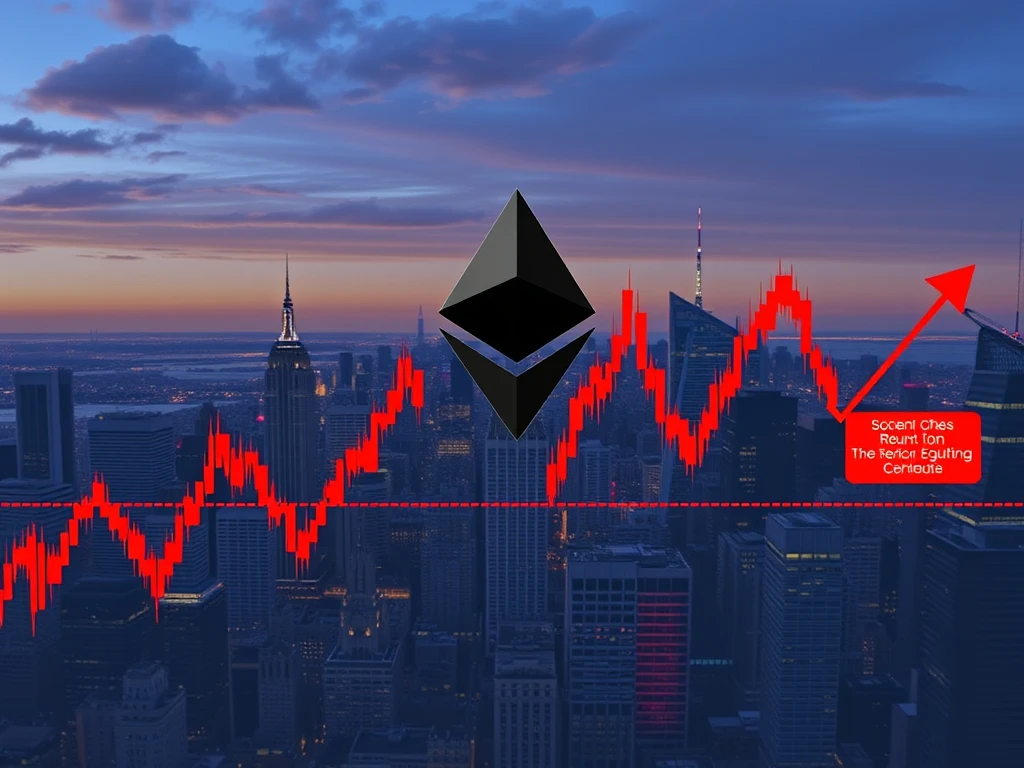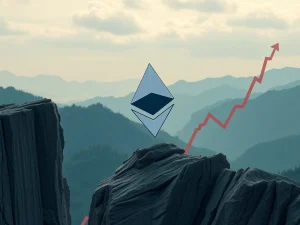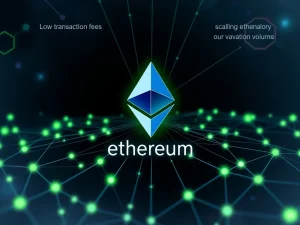Urgent Warning: 3 Reasons Ethereum Price Keeps Plunging – Is Recovery Possible?

Ethereum (ETH), a cornerstone of the crypto world, has been under significant pressure lately. While the broader crypto market shows signs of life, Ethereum price stubbornly lags behind. Investors are understandably anxious, wondering if this dip is just a temporary setback or a sign of deeper troubles. Let’s dissect the key factors contributing to this persistent downward trend and explore what needs to happen for a potential rebound in Ethereum price.
1. Alarming On-Chain Data: Ethereum Price Below Realized Price
One of the most concerning signals for Ethereum price comes from on-chain metrics, specifically the ‘realized price’. This metric essentially represents the average price at which all ETH coins were last moved on the blockchain. Currently, the spot price of ETH has fallen below this realized price. Historically, this is a bearish indicator.
Think of it this way: when the market price dips below the average purchase price, a large number of holders suddenly find themselves in a loss. This often triggers a ‘capitulation phase,’ where fear grips investors, leading to widespread selling and further price declines. We’ve seen this pattern before:
- June 2022 (Terra Luna Crash): Ethereum price fell below realized price, followed by a dramatic 51% crash.
- November 2022 (FTX Collapse): History repeated itself. A drop below realized price preceded a 35% plunge in Ethereum price after the FTX debacle.
Now, as we observe a similar scenario unfolding, the question looms: Is Ethereum price headed for another significant correction? The historical parallels are certainly unsettling and warrant serious attention from investors.
2. Disappointing Demand: Weak Spot Ethereum ETF Flows
The anticipation surrounding Spot Ethereum ETF approvals was a major driver of optimism earlier in 2024. However, the reality has been far from encouraging. Instead of the expected influx of institutional capital, Spot Ethereum ETFs are experiencing weakness.
Recent data paints a bleak picture:
- Over $3.3 million in net outflows were recorded on April 8th alone.
- In the past two weeks, these ETFs have suffered a staggering $94.1 million in net outflows, dwarfed by a mere $13 million in inflows.
This lack of investor appetite is a major red flag. Institutional demand was considered a cornerstone of Ethereum’s bullish narrative, and the current ETF flow data suggests a significant lack of conviction in Ethereum price at these levels. This bearish sentiment extends beyond ETFs, with CoinShares reporting $37.4 million in outflows from Ethereum investment funds in the week ending April 4th, mirroring the broader market’s negative sentiment.
3. Derivatives Market Downturn: Low Open Interest and Negative Funding Rates
Another worrying sign for Ethereum price is the lack of enthusiasm in the derivatives market. Two key indicators highlight this: Open Interest (OI) and Funding Rates.
Open Interest (OI): This represents the total number of outstanding futures and options contracts. A declining OI signals reduced trader participation and speculative activity. Currently, Ethereum’s OI sits at $16.7 billion, a massive 48% drop from its peak of $32.3 billion in January. This substantial decrease points to waning investor confidence and a drying up of buying pressure, further exacerbating the Ethereum price decline.
Funding Rates: In perpetual futures markets, funding rates reflect market sentiment. Negative funding rates, currently below 0% for Ethereum, indicate that short positions (bets against Ethereum price) are dominant. In this scenario, those betting against ETH are paying those holding long positions to keep their positions open. This clearly illustrates a prevailing bearish sentiment weighing down Ethereum price.
Beyond Price: Ethereum’s Network Activity Challenge
While not directly a price driver, Ethereum’s network activity is crucial for its long-term health. The rise of competing layer-1 blockchains is putting pressure on Ethereum’s dominance. High gas fees on Ethereum create opportunities for rivals like BNB Chain, Solana, Avalanche, and Tron, which offer greater scalability and lower costs.
While Layer-2 solutions on Ethereum are gaining traction, a portion of users and developers are still migrating to these alternative Layer-1 platforms. This shift is reflected in network activity metrics:
- Unique Active Wallets (UAW): Ethereum saw a 33% decrease in UAW over the last 30 days, significantly more than Solana’s 16% decrease and in stark contrast to Tron’s 16% increase.
- Transactions: Ethereum transactions dropped by 40.5% in the same period, while competitors like BNB Chain, Solana, and Avalanche experienced smaller decreases, and Tron and Fantom even saw increases.
This data suggests that Ethereum’s network activity growth is lagging behind its competitors, posing a long-term challenge to its market position.
Is a Reversal Imminent for Ethereum Price?
Currently, there are no clear indicators suggesting an immediate reversal of the factors dragging down Ethereum price. Weak ETF demand, bearish derivatives market signals, and network activity challenges all point towards continued pressure.
While a sustained downtrend isn’t guaranteed, technical analysis suggests that Ethereum price could potentially bottom out around the $1,000 mark if bearish momentum persists.
Disclaimer: This analysis is for informational purposes only and not financial advice. Crypto investments are risky; always conduct thorough research before making any decisions.









